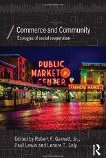Fostering Sustainable Complexity in the Microfinance Industry: Which Way Forward?
The microfinance movement has gained tremendous popularity over the past thirty years, but it is still far from meeting its full potential. The industry stands at a crossroads between increased commercialization and increased philanthropic aid. Standard economic discourse does little to resolve the debate. F. A. Hayek’s concept of the “extended order” sheds new light on how we might understand the future development of microfinance.
Whenever you are in doubt . . . apply the first test. Recall the face of the poorest and weakest man whom you may have seen, and ask yourself if the step you contemplate is going to be of any use to him. Will he gain anything from it? Will it restore him to a control over his own life and destiny? True development puts those first that society puts last.
—Mahatma Gandhi
An order in which everyone treated his neighbor as himself would be one where comparatively few could be fruitful and multiply. If we were, say, to respond to all charitable appeals that bombard us through the media, this would exact a heavy cost in distracting us from what we are most competent to do. . . . It would not provide a proper cure for misfortunes about which we are understandably concerned.
—F. A. Hayek (1988, 13)
Introduction
At the close of the colonial era, the dominant thinking among economic development theorists and policymakers was that poor countries would be lifted out of poverty through top-down, state development planning efforts. Governments could create prosperity, so the thinking went, by replicating the West’s industrial revolution in the developing world. Sector-wide development planning was considered the state of the art in the 1950s and 1960s, and despite abysmal results (in terms of economic decline, rampant corruption, and human rights atrocities), policies favoring heavy-handed state control of the economy persisted into the 1970s.
It was in the mid-1970s that frontline development organizations started to take notice of microenterprise1 and the informal sector in general as the primary mechanism by which poor people sustained themselves, met their day-to-day needs, and often improved their material conditions. BancoSol in Bolivia, the Grameen Bank in Bangladesh, and Bank Rakyat Indonesia (BRI) are just a few celebrated examples of how microfinance took off in the 1980s and continues to attract attention and funding. The growth of the microfinance movement marks a profound shift in how development theorists, practitioners, and policymakers think about economic development. Gone are discussions of how the state will fill the “entrepreneurial gap.” We now understand that the entrepreneurs have been there all along. What they need is an institutional environment that will allow them to play their part in the development process.
The appeal of the microfinance movement is that it seems to reverse all the mistakes of the old top-down paradigm. Rather than funneling resources through large (often corrupt) government bureaucracies that favor the political elite, microfinance offers capital-poor entrepreneurs (usually women) the small loans they need so that they can leverage their time and talent into a profitable enterprise. Furthermore, because microcredit organizations can mobilize savings among borrowers and lend at a market rate of interest, the microfinance industry has the potential to be self-sustaining, reducing dependence on foreign aid.
Since those early projects in the 1970s, microfinance has gathered steam both in the number of programs offering microfinance services and in the level of international financial support. In its 2003 annual summary, the Microcredit Summit Campaign reported that over 2,500 organizations, serving more than 67 million clients, submitted data to their campaign (Daley-Harris 2004). Though support for microfinance is still a small portion of international assistance overall, the microfinance movement has become a significant “player” in national and international politics. In 1998, the General Assembly of the United Nations adopted a resolution declaring 2005 as the International Year of Microcredit. In 2003, the United States Congress passed a law requiring all programs funded by the U.S. Agency for International Development (USAID) to use poverty assessment tools to ensure that at least 50 percent of the microcredit funds distributed by the organization reach clients living on less than US$1 per day. In 2003, more than six hundred parliamentarians from Australia, Canada, Japan, Mexico, the United States, and the United Kingdom signed a letter to the leaders of the World Bank; the Asian, African, and Inter-American Development Bank; and the United Nations Development Program (UNDP) to adopt similar measures and to double current spending on microfinance programs to US$1 billion annually.
Despite the growth of the movement to this point, however, the realities suggest that much work remains to be done. Microfinance in its current state is nowhere close to reaching its potential. Though tens of millions of clients are served through microcredit organizations, more than a billion people around the world are effectively locked out of the formal financial sector. As impressive as the record of growth has been to this point, if the industry is to serve the majority of poor people in the world, it will have to expand at much more dramatic rates.
Furthermore, with the exception of several dozen organizations, the industry is far from delivering on its promise of sustainability, if what we mean by sustainability is independence from the support of philanthropic donors. Though many organizations claim “operational sustainability,” the vast majority still require donor subsidies to cover their capital costs. Between 1985 and 1996 the Grameen Bank, for example, reported “profits” of $1.5 million. But as Morduch (1999) observes, when modest adjustments are made to standardize Grameen’s accounting practices and philanthropic subsidies on capital are considered, the bank is shown to have actually incurred $34 million in losses during the same period.
The point of raising these concerns is not so much to criticize the industry as to recognize that its success has brought it to a critical crossroads. The path forward will determine whether the great potential of microenterprise to serve the billion or so people who are currently locked out of the traditional financial sector can be realized.
So, the question arises: which way forward?




